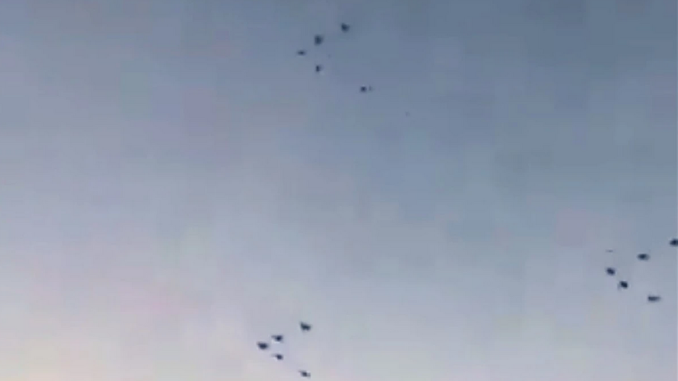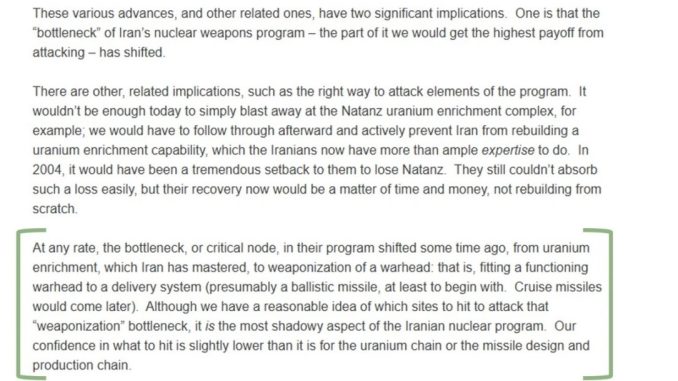Peloni: J.E. Dyer provides a granular examination of the evidence that Israel did indeed strike a facility known to previously be connected to a highly sensitive aspect of Iran’s nuclear program, and which will be difficult for Iran to replace should the strike have had its desired effect.
Understated event; effect that probably can’t be overstated.
J.E. Dyer, a retired Naval Intelligence officer, blogs as The Optimistic Conservative, October 30, 2024
 IAF strike-fighters in formation return from the 26 October strikes against targets in Iran. Video posted by Jewish News Syndicate on X/Twitter.
IAF strike-fighters in formation return from the 26 October strikes against targets in Iran. Video posted by Jewish News Syndicate on X/Twitter.
The purpose of this article is to highlight the nuclear program target struck in Iran by Israel on 26 October 2024. Public reporting has not counted this target as a “nuclear program target.” But the history of the facility is connected solely to the Iranian nuclear weapons program, and there is good reason to believe it continues to be. The fact that Israel found it worth attacking in a limited strike is a strong indication of that – whatever its current state of activity.
(Note: See the tweeted information from the ISIS Institute below, posted at X/Twitter since this article was begun.)
The target, if it retained the character of its surrounding, operationally-linked buildings, would be an element of the remaining “critical node” in Iran’s path to a bomb.
A “critical node,” in the analysis of an enterprise like developing a nuclear weapon, is a bottleneck: something that previous paths funnel down to, and something that must be passed through successfully to reach the goal of the enterprise. A critical node cannot be bypassed. It must be successfully negotiated.
In the case of this target, the critical node in question is developing a “detonatable” weapon. It’s providing the controlled detonation element, to make a bomb out of a package of fissile material (that is, the uranium enriched to weapons grade). Just as mating the bomb to a delivery mechanism, such as a missile, is necessary to have a weapon and use it efficiently, so mating the fissile material to a detonation device is necessary in order to have a “bomb.”
With a bomb and delivery mechanism, the user then has a weapon usable against his targets of choice, and not just a lot of dangerous materials lurking near himself.
I actually wrote about this back in January 2015, because at that point, the “next critical node” in Iran’s weapons program had already shifted to the bottleneck of weaponizing a bomb. Higher enrichment of uranium was mastered, and Iran had produced and tested medium-range ballistic missiles capable of delivering a nuclear warhead of useful size.
I summarized the situation thus:

Excerpt from 2015 article at Liberty Unyielding; link in text. All images; click through to enlarge for legibility.
It’s essential to observe that Israel’s 2018 raid in Tehran substantially increased the confidence we might have in which targets to strike in Iran to set back the critical node of weaponizing a bomb. As of 2024, it’s the critical node to attack. In the terms I outlined in 2015, it’s the highest-payoff target set for what targeteers call “K-Kill” destruction; i.e., to a level that the entire function of a targeted system is lost, and will take a long time to replace, relative to the horizon of political objectives (in this case, preventing Iran from getting a bomb).
With that in mind, the target Israel struck on 26 October was a building called by the Iranians “Taleghan 2,” the second of two main buildings at a high-explosive (HE) test site at the northern extreme of the Parchin complex east of Tehran. The other building is referred to as Taleghan 1. The testing site was used just over 20 years ago to perform tests for development of an HE detonation device for a nuclear weapon. (See this article from the ISIS Institute in 2018 for extensive background. For ease of access to the Institute’s full slate of Iran material, go to this anchor page for the 2018 article, from which you can navigate to the rest of the published material.)
This is what I posted on X/Twitter shortly after the strike, noting the nuclear-related target in the 26 October strike set.
Although 20 years seems like a long time, there are two salient points about this site with the Taleghan buildings. One is that the archival material retrieved by Israel’s 2018 raid in Tehran confirms the significance of the site, and the buildings’ participation in live testing. The nature of Iran’s quest for a detonation device has been known in the West since at least 2003, when an Iranian laptop containing summaries of studies on developing such a device was provided to the UN by a member state (never named). Since acknowledging the studies and deeming them a form of credible evidence, IAEA has referred to them as the “Alleged Studies.” Prior to implementation of the JCPOA and UNSCR 2231 (both from 2015) in January 2016, Iran was supposed to provide answers to longstanding IAEA questions about the Alleged Studies.
Unfortunately, as the ISIS Institute puts it, IAEA let Iran off the hook in late 2015 for satisfactory answers to those questions. This was undoubtedly (my view) at the behest of the Western sponsors of the JCPOA, which were the only actors that could have forced full answers from Iran.
In any case, at one time IAEA believed that although studies and some preparatory work had been done between 2000 and 2004, it appeared that the Iranians had stopped short of live testing.
The archive seized by Israel showed otherwise. There was indeed live testing done in 2003 through 2004.
The second point is that the testing is evidence of Iran’s pursuit of nuclear weapons, and a considerable amount of such testing has already been done. There is probably more needed to fully perfect a working bomb that can be delivered for a controlled, intended effect. But the Iranians would not be starting from scratch. The long-preparation aspect of such development has been substantially addressed. Infrastructure was in place 20 years ago, and if it’s not still at the Parchin test site, it went somewhere.
The two buildings and the supporting infrastructure at the site in question were part of what Iran referred to in the Tehran archives as the “AMAD” program. (For brevity, I won’t be expanding or speaking to the background of these programs in this article. Read the Institute’s article for such details. “AMAD” in the archives signified a key element of the Iranian nuclear weapons program.)
Four of the AMAD program facilities were located in proximity to each other in the northern reaches of the Parchin complex.



Leave a Reply
You must be logged in to post a comment.